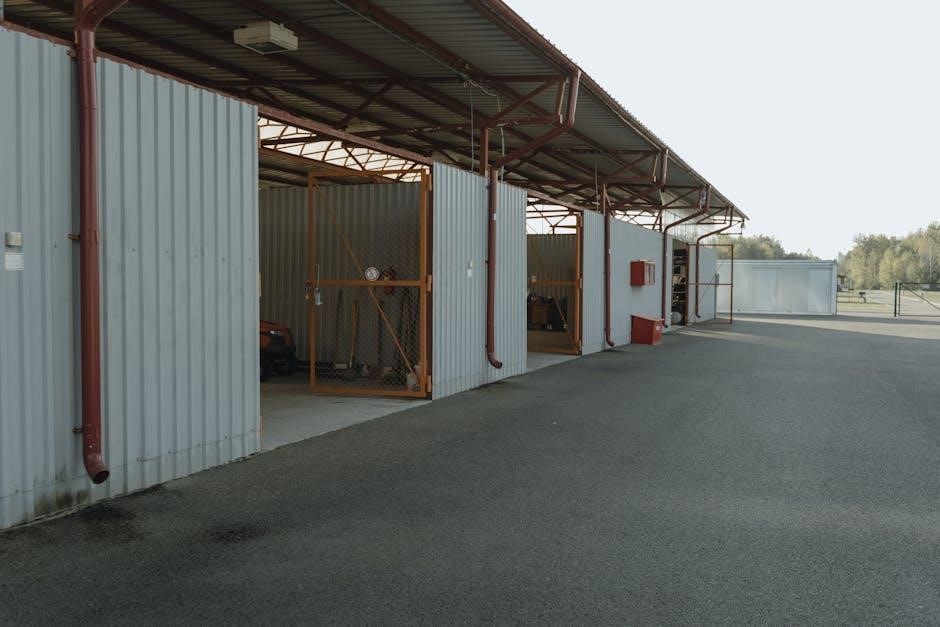IRS Form 8027 is used by employers to report tip income and allocated tips for large food or beverage establishments, ensuring compliance with IRS regulations.
Overview of Form 8027
IRS Form 8027 is an annual information return used by employers in the food and beverage industry to report tip income and allocated tips. It applies to large food or beverage establishments, defined as those with more than 10 employees based on average hours worked. The form ensures compliance with IRS regulations by detailing gross receipts from food and beverage sales, total tips received, and tips allocated to employees. It also helps employers verify accurate tip reporting by employees, preventing penalties and ensuring proper tax compliance. The form is essential for businesses like restaurants and bars where tipping is customary.
Purpose of the Form
The primary purpose of Form 8027 is to enable employers to report tip income and allocated tips accurately to the IRS. It ensures employers comply with tax regulations by disclosing total tips received, tips paid to employees, and any allocated tips if employees underreport their tips. Additionally, the form helps employers claim the tip credit, reducing their tax liability. By providing detailed information about food and beverage sales and tip allocations, Form 8027 promotes transparency and accountability in tip reporting, ensuring both employers and employees meet their tax obligations effectively. It also aids the IRS in monitoring compliance with tip-related tax laws.

Filing Requirements and Deadlines
Employers must file Form 8027 by February 28 of the year following the tax year. Electronic filers have until March 31. Extensions can be requested using Form 8809.
Who Must File Form 8027
Employers operating large food or beverage establishments must file Form 8027. A large establishment is defined as one where tipping is customary and the average number of employee hours worked exceeds 10 per business day. This determination is made using the 10-employee test, which is detailed in the IRS instructions. Employers with multiple qualifying establishments must file a separate Form 8027 for each location. Fast-food businesses, where customers order and pick up food themselves, are typically excluded from this requirement. The form ensures accurate reporting of tip income and allocated tips for compliance with IRS regulations.
Deadline for Filing
The deadline for filing Form 8027 is February 28 of the year following the calendar year being reported. For electronic filers, the deadline extends to March 31. Employers can request an extension by submitting Form 8809, but this must be done no earlier than January 1 and no later than February 28 of the filing year. Missing the deadline may result in penalties, so timely submission is crucial. The IRS provides these deadlines to ensure employers have sufficient time to gather and report accurate tip income and sales data for their food or beverage establishments.
Electronic Filing Options
Employers can file Form 8027 electronically, which offers convenience and accuracy. The IRS accepts electronic submissions through approved software or platforms, extending the deadline to March 31. Electronic filing reduces errors and expedites processing. To e-file, employers must ensure their software supports IRS specifications for Form 8027. Additionally, filers can request an extension using Form 8809, but electronic submissions must still meet the March 31 deadline. The IRS encourages electronic filing for its efficiency and to streamline the reporting process for tip income and sales data.

Understanding the 10-Employee Test
IRS Form 8027 requires the 10-employee test to determine if an establishment qualifies as a large food or beverage establishment based on average employee hours per business day.
Definition of a Large Food or Beverage Establishment
A large food or beverage establishment is defined by the IRS as a business where food or drinks are provided to customers, and it meets the 10-employee test. This test calculates if more than 10 employees, based on average hours worked per business day, are employed. Fast-food businesses where customers order and pick up their food themselves are excluded. Establishments must use the IRS-provided worksheet to determine if they meet this criterion, ensuring accurate reporting for Form 8027 compliance.
Worksheet for Determining Filing Requirement
The IRS provides a worksheet to help employers determine if they must file Form 8027. This worksheet assesses whether an establishment qualifies as large based on the 10-employee test. Employers calculate the average number of employee hours worked per business day during peak periods. If the total exceeds the threshold, the establishment is considered large and must file Form 8027. The worksheet ensures accurate compliance by guiding employers through the necessary calculations step-by-step, avoiding potential penalties for incorrect filing status.

Reporting Food and Beverage Sales
Employers report food and beverage sales on Form 8027, including gross receipts from cash, credit, and complimentary items. Tips are typically excluded unless deducted from sales.
What Constitutes Gross Receipts
Gross receipts on Form 8027 include all income from food or beverage sales, such as cash, credit card transactions, and the retail value of complimentary items served to customers. This also encompasses charges to a hotel room, excluding tips charged to the hotel room. Notably, tips are generally not included in gross receipts unless they were deducted from cash sales. Employers must accurately report these amounts to ensure compliance with IRS regulations and proper calculation of related tip allocations.
Including Tips in Gross Receipts
Tips are generally not included in gross receipts unless they were deducted from cash sales. If tips were deducted from cash sales, they must be added back to calculate gross receipts. However, tips charged to a hotel room are excluded. Gross receipts encompass cash sales, credit card receipts, and the retail value of complimentary food or drinks served. This ensures accurate reporting of food and beverage sales, aligning with IRS requirements for Form 8027. Proper inclusion or exclusion of tips is essential for correct compliance and reporting standards.

Tip Income and Allocated Tips
IRS Form 8027 reports total tips received and allocated tips to employees, ensuring compliance with IRS tip reporting requirements for large food and beverage establishments.
Reporting Total Tips Received
Employers must report the total tips received by their establishment on Form 8027. This includes all tips collected from customers, whether in cash, credit card charges, or other forms. Tips are generally not included in gross receipts unless they were deducted from cash sales. The total tips received are reported on a specific line of the form, ensuring accurate tracking for tax compliance. This step is crucial for verifying that employees report their tip income correctly and for calculating allocated tips when necessary. Accurate reporting helps avoid penalties and ensures proper tax obligations are met.
Allocating Tips to Employees
Employers must allocate tips to employees when necessary, ensuring fairness and compliance with IRS regulations. Tips are allocated based on the hours-worked method or other approved methods, as detailed in the instructions. The allocated amount is reported on Form 8027 and must be documented accurately. Employers should maintain records of tip distributions and ensure allocations are reasonable and proportionate to employees’ roles. Accurate allocation helps prevent penalties and ensures employees receive fair credit for their tip income, aligning with IRS requirements for transparency and equity in tip reporting and distribution. Proper documentation is essential for compliance.
Completing the Form Step-by-Step
Begin with basic business information, then follow line-by-line instructions to report sales, tips, and allocations. Ensure accuracy to avoid penalties and comply with IRS requirements.
Basic Business Information
Start by providing the establishment’s name, address, and Employer Identification Number (EIN). Include the employer’s name and address if different from the establishment. Indicate if the business is a fast-food establishment or part of a chain. For multiple locations, list each separately. Ensure accuracy in reporting the EIN and business details to avoid delays or penalties. This section sets the foundation for the rest of the form, ensuring proper identification and compliance with IRS requirements. Complete this step carefully to maintain clarity and accuracy throughout the filing process.
Line-by-Line Instructions
Start with Line 1, reporting gross receipts from food and beverage sales, excluding non-allocable receipts. Line 2 requires charged tips, while Line 3 calculates total tips received. Line 4 shows tip allocations, and Line 5 indicates the number of employees. Lines 6 and 7 address the 10-employee test and allocation methods. Line 8 reports the average hours worked per employee. Each line must be filled accurately to ensure compliance and avoid penalties. Follow the IRS instructions carefully for each section to maintain precision and completeness in your reporting.
Special Considerations
Employers with multiple food or beverage establishments must file separate Form 8027 for each. Fast-food businesses are excluded if customers order and pick up their own food.
Multiple Establishments and Separate Filings
Employers operating multiple food or beverage establishments must file a separate Form 8027 for each location. Each establishment is treated independently, and the 10-employee test applies to each one. If an employer has more than one establishment meeting the criteria, they must submit individual forms for accurate reporting. Failure to file separate forms may result in penalties or delays in processing.
Additionally, establishments that qualify as fast-food businesses, where customers order, pay, and pick up their food themselves, are excluded from filing Form 8027. This exclusion simplifies reporting for such businesses.
Exclusions for Fast Food Businesses
Fast-food businesses are excluded from filing Form 8027 if customers order, pay, and pick up their food themselves. Establishments where tipping is not customary, such as quick-service restaurants, are not required to report tip income. This exclusion simplifies compliance for businesses that do not rely on tips as part of employee income. However, if tipping is customary and the business meets the 10-employee test, Form 8027 must be filed. The IRS defines fast-food businesses based on customer interaction and payment methods, ensuring accurate reporting for applicable establishments only.

Penalties and Compliance
Failure to file Form 8027 timely or accurately can result in penalties. Employers must ensure compliance to avoid IRS issues and ensure accurate tip reporting.
Consequences of Late or Incomplete Filing
Failing to file Form 8027 on time or submitting incomplete information can result in penalties. Late filing may lead to fines and interest on unpaid taxes. Incomplete filings can trigger IRS notices, requiring corrections and potentially additional penalties. Employers must ensure accuracy and timeliness to avoid compliance issues. The IRS may also impose penalties for underreporting tip income or allocated tips, affecting both the employer and employees. Proper reporting is essential to maintain compliance and avoid legal complications.
Ensuring Accuracy in Reporting
Accurate reporting on Form 8027 is crucial to avoid penalties and ensure compliance with IRS regulations. Employers must verify the accuracy of tip income, allocated tips, and gross receipts before filing. Ensure all data, such as sales figures and tip allocations, is correct and complete. Use worksheets provided in the IRS instructions to calculate allocations properly. Double-checking entries and ensuring compliance with the 10-employee test helps prevent errors. Maintaining detailed records of tips and sales supports accurate reporting and simplifies audits. Precise reporting ensures employers meet their obligations and avoid potential IRS issues.

Additional Resources
Visit the IRS website for detailed Form 8027 instructions, guidelines, and related publications. Utilize professional tax tools and resources for accurate filing and compliance assistance.
IRS Guidelines and Publications
The IRS provides comprehensive guidelines and publications to assist with Form 8027. These resources include detailed instructions, worksheets, and examples to help employers accurately report tip income and allocated tips. The official IRS website offers access to current and prior versions of Form 8027, along with electronic filing specifications. Employers can refer to these materials to ensure compliance with reporting requirements and avoid penalties. Additionally, the IRS publishes updates and changes to tip reporting regulations, making it essential to review the latest guidelines annually.
Professional Assistance and Tools
Employers can seek professional assistance from tax professionals or CPAs to ensure accurate completion of Form 8027. Utilizing software tools like QuickBooks can simplify tracking and reporting of tips and sales data. Additionally, the IRS provides resources and tools on their website to aid in understanding and filing the form correctly.



